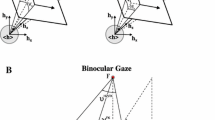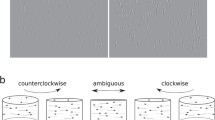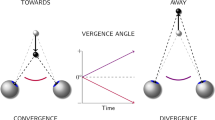Abstract
In binocular systems,vergence is the process of adjusting the angle between the eyes (or cameras) so that both eyes are directed at the same world point. Its utility is most obvious for foveate systems such as the human visual system, but it is a useful strategy for nonfoveate binocular robots as well. Here, we discuss the vergence problem and outline a general approach to vergence control, consisting of a control loop driven by an algorithm that estimates the vergence error. As a case study, this approach is used to verge the eyes of the Rochester Robot in real time. Vergence error is estimated with the cepstral disparity filter. The cepstral filter is analyzed, and it is shown in this application to be equivalent to correlation with an adaptive prefilter; carrying this idea to its logical conclusion converts the cepstral filter into phase correlation. The demonstration system uses a PD controller in cascade with the error estimator. An efficient real-time implementation of the error estimator is discussed, and empirical measures of the performance of both the disparity estimator and the overall system are presented.
Similar content being viewed by others
References
Abbott, A.L. and Ahuja, N. 1988. “Surface reconstruction by dynamic integration of focus, camera vergence, and stereo.”Proc. 2nd Intern. Conf. Comput. Vision, Tampa.
Aloimonos, J., Weiss, I., and Bandyopadhyay, A. 1988. “Active vision.”Internat. J. Comput. Vision 1(4):333–356.
Analog Devices. 1987.DSP Product Databook. Analog Devices, Inc.: Norwood, MA.
Bajcsy, R. 1986. “Passive perception vs. active perception.”Proc. 4th IEEE Workshop Comput. Vision, Ann Arbor.
Ballard, D.H. 1989. “Reference frames for animate vision.”Proc. 11th Intern. Joint Conf. Artif. Intell., Detroit.
Ballard, D.H., and Ozcandarli, A. 1988. “Eye movements and visual cognition: Kinetic depth.”Proc. 2nd Intern. Conf. Comput. Vision, Tampa.
Bandyopadhay, A. 1986. “A computational study of rigid motion perception.” Ph.D. thesis, University of Rochester; also published as Computer Science Department TR 221.
Bar-Shalom, Y., and Fortman, T.E. 1988.Tracking and Data Association. Academic Press: San Diego.
Barnard, S.T., and Fischler, M.A. 1982. “Computational stereo.”Computing Surveys, 14(4):553–572.
Bogert, B.P., Healy, M.J.R., and Tukey, J.W. 1963. “The quefrency analysis of time series for echoes: Cepstrum, pseudoautocovariance, cross-cepstrum, and saphe cracking.” In M. Rosenblatt, editor,Proc. Symp. Time Series Anal. Wiley, pp. 209–243.
Brooks, R.A. 1986. “A robust layered control system for a mobile robot.”IEEE J. Robot. Autom. 2:14–23, April.
Brooks, R.A. 1987. “Intelligence without representation.”Proc. Workshop on Foundations of Artificial Intelligence, pp. 1–21.
Brown, C.M. 1990a. “Gaze controls cooperating through prediction.”Image and Vision Computing 8(1):10–17.
Brown, C.M. 1990b. “Gaze controls with interactions and delays.”IEEE Trans. Syst., Man, Cybern. IEEE-TSMC20(3).
Brown, C.M. 1990c. “Prediction and cooperation in gaze control.”Biological Cybernetics 63, May.
Brown, C.M. et al. 1988. “The Rochester robot.” Technical Report 257, Unviersity of Rochester, Computer Science Department.
Burt, P.J., and Adelson, E.H. 1983. “The Laplacian pyramid as a compact image code.”IEEE Trans. Communications 31(4):532–540.
Clark, J. and Ferrier, N. 1988. “Modal control of an attentive vision system.”Proc. 2nd Intern. Conf. Comput. Vision, Tampa.
Coombs, D.J. 1989. “Tracking objects with eye movements.” InProc. Topical Meet. Image Understand. Mach. Vision, North Falmouth, Cape Cod, MA, June. Optical Society of America.
Coombs, D.J. and Brown, C.M. 1990. “Intelligent gaze control in binocular vision.”Proc. 5th IEEE Intern. Symp. Intell. Control., Philadelphia, September.
Coombs, D.J. and Brown, C.M. 1991. “Cooperative gaze holding in binocular vision.”IEEE Cont. Syst. Mag., June.
Dorf, R.C. 1980.Modern Control Systems. 3rd ed., Addison-Wesley: Reading, MA.
Erkelens, C., et al. 1989a. “Ocular vergence under natural conditions I: Continuous changes of target distance along the median plane.”Proc. Roy. Soc. London.
Erkelens, C., Steinman, R., and Collewijn, H. 1989b. “Ocular vergence under natural conditions II: Gaze shifts between real targets differing in distance and direction.”Proc. Roy. Soc. London.
Erkelens, C.J. and Regan, D. 1984. “Human oscular vergence movements induced by changing size and disparity,”Journal of Physiology 379:145–169.
Fleet, D.J., Jepson, A.D., and Jenkin, M.R.M. 1989. “Phase-based disparity measurement.” Research in Biological and Computational Vision RBCV, TR-89-29, Department of Computer Science, University of Toronto, November.
Geiger, D., and Yuille, A. 1987. “Stereopsis and eye-movement.”Proc 1st Intern. Conf. Comput. Vision, London, pp. 306–314.
Horn, B.K.P. 1986.Robot Vision. MIT Press: Cambridge, MA.
Howard, I. and Simpson, W. 1989. “Human optokinetic nystagmus is linked to the stereoscopic system.”Exper. Brain Res.
Jepson, A.D., and Jenkin, M. 1989. “The fast computation of disparity from phase differences.”Proc. IEEE Conf. Comput. Vision Patt. Recog., San Diego, June, pp. 398–403.
Krotkov, E.P. 1989.Active Computer Vision by Cooperative Focus and Stereo, Springer-Verlag: New York.
Kuglin, C.D. and Hines, D.C. 1975. “The phase correlation image alignment method.”Proc. IEEE Intern. Conf. Cyber. Soc., pp. 163–165.
Maxwell, J.S., and King, W.M. 1990. “Disjunctive saccades contribute to vergence in rhesus monkeys.”Abst. Soc. Neurosci.
Miles, F.A., Schwartz, U., and Busettini, C. 1990. “The decoding of optic flow by the primate optokinetics system.” In A., Berthoz, P.-P., Vidal, and W., Graf, editors,The Head-Neck Sensory-Motor System. Oxford University Press: New York, in press.
Nishihara, H.K. 1984. “Practical real-time imaging stereo matcher.”Optical Engineering 23(5):536–545.
Olson, T.J. 1991. “Stereopsis for fixating systems.” InProc. IEEE Intern. Conf. Syst., Man Cyber., Charlottesville, VA, October (accepted for publication).
Olson, T.J., and Potter, R.D. 1989. “Real-time vergence control.”Proc. Conf. Comput. Vision Patt. Recog. San Diego, June, pp. 404–409. Also available as University of Rochester Computer Science Department Technical Report 246.
Paige, G.D. 1990. “Modulation of the linear vertibulo-ocular reflex (LVOR) by vergence.”Investig. Ophthal. Vis. Sci. 31(4):121; Annual ARVO Meeting Abstract Issue.
Pearson, J.J., Hines, D.C., Jr., Golosman, S., and Kuglin, C.D. 1977. “Video-rate image correlation processor.”Proc. SPIE vol. 119 Application of Digital Image Processing, San Diego, pp. 197–205.
Rimey, R.D., and Brown, C.M. 1990. “Selective attention as sequential behavior: Modelling eye movements with an augmented hidden Markov model.”Proc. of the DARPA Image Understanding Workshop, Pittsburgh, PA, September.
Robinson, D. 1987. “Why visuomotor systems don't like negative feedback and how they avoid it.” In Michael, Arbib and Allen, Hanson, editors,Vision, Brain and Cooperative Computation, MIT Press: Cambridge, MA.
Rojer, A.S., and Schwartz, E.L. 1990. “Design considerations for a space-variant visual sensor with complex-logarithmic geometry.”Proc. Intern. Conf. Patt. Recog. Philadelphia, PA, June.
Snyder, L.H., Pickle, D.M., and King, W.M. 1990. “Does instantaneous vergence angle modify the vestibulo-ocular reflex in monkeys?”Invest. Ophthal. Vis. Sci. 31(4):121, Annual ARVO Meeting Abstsract Issue.
Tilley, D.G. 1990. “Zebra for MaxVideo: an application of object oriented microprogramming to register level devices.” Technical Report 315, University of Rochester, Computer Science Department.
Tistarelli, M., and Sandini, G. 1990. “On the estimation of depth from motion using an anthropomorphic visual sensor.”Proc. Europ. Conf. Comput. Vision, Antibes, Fr.
Tsotsos, J.K. 1988. “A ‘complexity level’ analysis of vision.”Intern. J. Comput. Vision 1(4).
Van der, Spiegel, J., et al. 1989. “A foveated retina-like sensor using CCD technology.” In C., Mead and M., Ismail, editors,Analog VLSI Implementation of Neural Systems. Kluwer: Norwell, MA.
Yarbus, A.L. 1967.Eye Movements and Vision. Plenum Press: New York.
Yeshurun, Y. and Schwartz, E. 1989. “Cepstral filtering on a columnar image architecture: A fast algorithm for binocular stereo segmentation.”IEEE Trans. Patt. Anal. Mach. Intell. II(7).
Author information
Authors and Affiliations
Rights and permissions
About this article
Cite this article
Olson, T.J., Coombs, D.J. Real-time vergence control for binocular robots. Int J Comput Vision 7, 67–89 (1991). https://doi.org/10.1007/BF00130490
Received:
Revised:
Issue Date:
DOI: https://doi.org/10.1007/BF00130490




